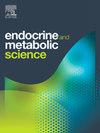Assessment of periostin in postmenopausal thyroid patients: A prospective case-control study
Q3 Medicine
引用次数: 0
Abstract
Objective
To evaluate the relationship between periostin in postmenopausal hypothyroid women.
Methodology
A prospective case-control study was conducted at Rajendra Memorial Research Institute of Medical Sciences (RMRIMS) Hospital, Agamkuan, Patna, India. The study includes 38 postmenopausal hypothyroid women as case and 38 healthy women as control. Demographic details and anthropometric measurements were included. Biochemical parameters like triiodothyronine (T3), tetraiodothyronine (T4), thyroid stimulating hormone (TSH), calcitonin, calcium, phosphorous, creatinine and albumin were determined. Serum periostin level was measured in case as well as in control subjects. Statistical Package for the Social Sciences (SPSS) version 22 was used to perform statistical analysis.
Results
Significant differences were noted in hip circumference (HC), waist hip ratio (WHR), white blood cells (WBC), T3, TSH, creatinine, calcium, phosphorous, high-density lipoprotein (HDL), low-density lipoprotein (LDL), triglycerides, and periostin levels between hypothyroid and euthyroid patients. Euthyroid patients had lower TSH and higher T3 levels, while periostin was higher in hypothyroid subjects. Correlation analysis showed periostin shows positive correlation with height and WBC, and negative correlation with T3, T4, and creatinine. Whereas, TSH shows positive correlation with creatinine in hypothyroid cases and shows negative correlation with weight and body mass index (BMI).
Conclusion
Hypothyroid patients observed with higher serum periostin levels in comparison to euthyroid individuals. Further research on periostin in large population is required in hypothyroid cases along with bone mineral density (BMD) to be explored as a possible biomarker.
评估绝经后甲状腺患者的骨膜素:一项前瞻性病例对照研究
目的探讨绝经后甲状腺功能减退妇女血清骨膜素与甲状腺功能减退的关系。方法在印度巴特那Agamkuan的Rajendra纪念医学科学研究所(rrimms)医院进行了一项前瞻性病例对照研究。该研究包括38名绝经后甲状腺功能减退妇女作为病例和38名健康妇女作为对照。包括人口统计细节和人体测量数据。测定三碘甲状腺原氨酸(T3)、四碘甲状腺原氨酸(T4)、促甲状腺激素(TSH)、降钙素、钙、磷、肌酐、白蛋白等生化指标。测定病例组和对照组血清骨膜蛋白水平。使用社会科学统计软件包(SPSS)第22版进行统计分析。结果甲状腺功能低下患者与甲状腺功能正常患者的臀围(HC)、腰臀比(WHR)、白细胞(WBC)、T3、TSH、肌酐、钙、磷、高密度脂蛋白(HDL)、低密度脂蛋白(LDL)、甘油三酯、骨膜蛋白水平均有显著差异。甲状腺功能正常的患者TSH水平较低,T3水平较高,而甲状腺功能低下的患者骨膜素水平较高。相关性分析显示,骨膜蛋白与身高、WBC呈正相关,与T3、T4、肌酐呈负相关。甲状腺功能减退患者TSH与肌酐呈正相关,与体重、体质指数(BMI)呈负相关。结论甲状腺功能减退患者血清骨膜蛋白水平高于甲状腺功能正常者。在甲状腺功能减退病例中,骨密度(BMD)作为一种可能的生物标志物,需要在大人群中进一步研究骨膜蛋白。
本文章由计算机程序翻译,如有差异,请以英文原文为准。
求助全文
约1分钟内获得全文
求助全文
来源期刊

Endocrine and Metabolic Science
Medicine-Endocrinology, Diabetes and Metabolism
CiteScore
2.80
自引率
0.00%
发文量
4
审稿时长
84 days
 求助内容:
求助内容: 应助结果提醒方式:
应助结果提醒方式:


